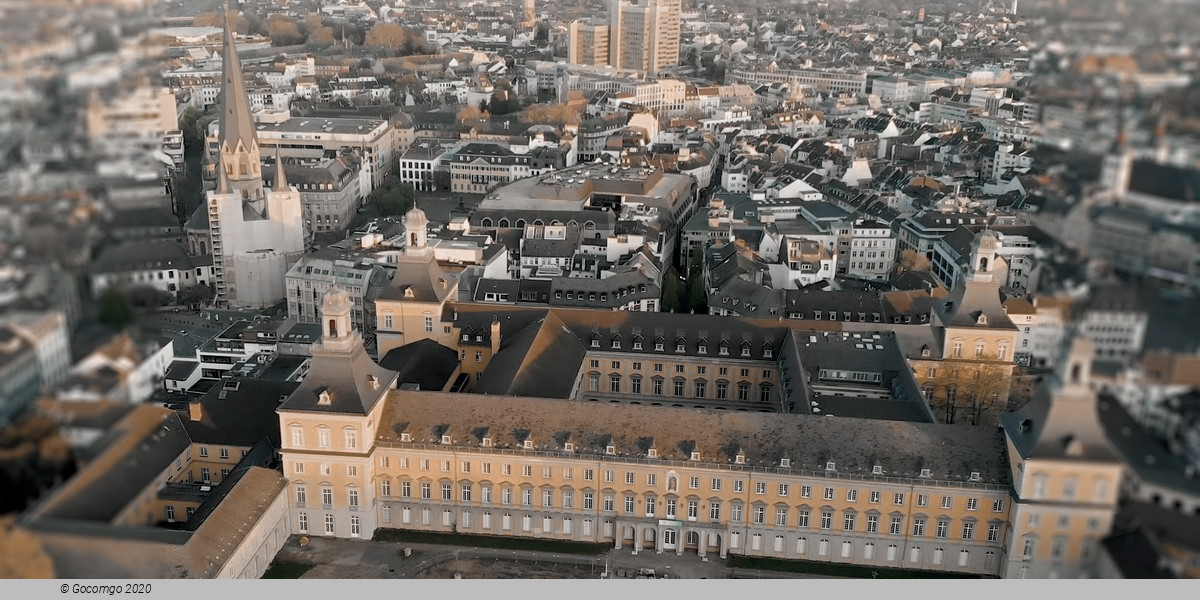Bonn

Bonn is a city in the western part of Germany on the river Rhine. This is the birthplace of the famous composer Beethoven, so his memorial and house-museum are located here. Not far from the museum rises the cathedral in the Romanesque-Gothic style. Nearby are the rose-gold building of the Old Town Hall and Poppelsdorf Castle, which houses the Mineral Museum. In the southern part of the city is the House of the History of Germany, where you can get acquainted with the history of the country after the Second World War.
Beethoven's birthplace is located in Bonngasse near the market place. Next to the market place is the Old City Hall, built in 1737 in Rococo style, under the rule of Clemens August of Bavaria. It is used for receptions of guests of the city, and as an office for the mayor. Nearby is the Kurfürstliches Schloss, built as a residence for the prince-elector and now the main building of the University of Bonn.
The Poppelsdorfer Allee is an avenue flanked by Chestnut trees which had the first horsecar of the city. It connects the Kurfürstliches Schloss with the Poppelsdorfer Schloss, a palace that was built as a resort for the prince-electors in the first half of the 18th century, and whose grounds are now a botanical garden (the Botanischer Garten Bonn). This axis is interrupted by a railway line and Bonn Hauptbahnhof, a building erected in 1883/84.
The Beethoven Monument stands on the Münsterplatz, which is flanked by the Bonn Minster, one of Germany's oldest churches.
The three highest structures in the city are the WDR radio mast in Bonn-Venusberg (180 m or 590 ft), the headquarters of the Deutsche Post called Post Tower (162.5 m or 533 ft) and the former building for the German members of parliament Langer Eugen (114.7 m or 376 ft) now the location of the UN Campus.
Just as Bonn's other four major museums, the Haus der Geschichte or Museum of the History of the Federal Republic of Germany, is located on the so-called Museumsmeile ("Museum Mile"). The Haus der Geschichte is one of the foremost German museums of contemporary German history, with branches in Berlin and Leipzig. In its permanent exhibition, the Haus der Geschichte presents German history from 1945 until the present, also shedding light on Bonn's own role as former capital of West Germany. Numerous temporary exhibitions emphasize different features, such as Nazism or important personalities in German history.
The Kunstmuseum Bonn or Bonn Museum of Modern Art is an art museum founded in 1947. The Kunstmuseum exhibits both temporary exhibitions and its permanent collection. The latter is focused on Rhenish Expressionism and post-war German art. German artists on display include Georg Baselitz, Joseph Beuys, Hanne Darboven, Anselm Kiefer, Blinky Palermo and Wolf Vostell. The museum owns one of the largest collections of artwork by Expressionist painter August Macke. His work is also on display in the August-Macke-Haus, located in Macke's former home where he lived from 1911 to 1914.
The Bundeskunsthalle (full name: Kunst- und Ausstellungshalle der Bundesrepublik Deutschland or Art and Exhibition Hall of the Federal Republic of Germany), focuses on the crossroads of culture, arts, and science. To date, it attracted more than 17 million visitors. One of its main objectives is to show the cultural heritage outside of Germany or Europe. Next to its changing exhibitions, the Bundeskunsthalle regularly hosts concerts, discussion panels, congresses, and lectures.
The Museum Koenig is Bonn's natural history museum. Affiliated with the University of Bonn, it is also a zoological research institution housing the Leibniz-Institut für Biodiversität der Tiere. Politically interesting, it is on the premises of the Museum Koenig where the Parlamentarischer Rat first met. The Deutsches Museum Bonn, affiliated with one of the world's foremost science museums, the Deutsches Museum in Munich, is an interactive science museum focusing on post-war German scientists, engineers, and inventions. Other museums include the Beethoven House, birthplace of Ludwig van Beethoven, the Rheinisches Landesmuseum Bonn (Rhinish Regional Museum Bonn), the Bonn Women's Museum, the Rheinisches Malermuseum and the Arithmeum.

